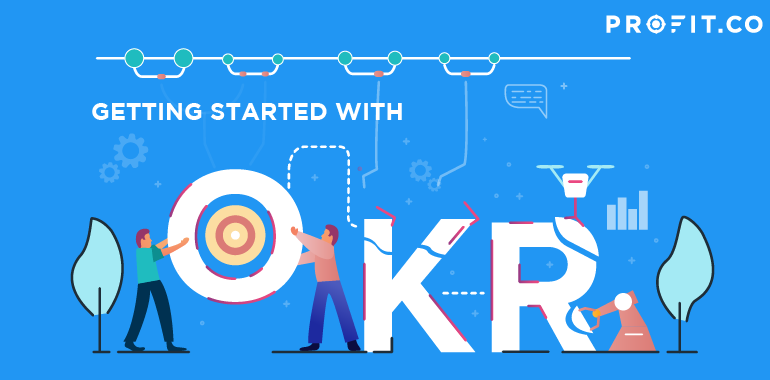While everyone prepares for their OKR programs differently, chances are you have done a few things. Perhaps you’ve read literature on OKRs and have prepared with an understanding of the methodology. Perhaps you’ve identified your goals and measurements and are ready to begin. Or maybe you want to learn by doing.
No matter how much time and effort you have put into preparing to implement your OKR program, you can still feel lost or overwhelmed, unsure where exactly to begin.
In this article, we’ll answer the question: how do I get started? With tips for implementing your OKR program and examples of how your company will work together to reach your ambitious goals.
You don’t have to be great to start, but you have to start to be great.
Begin with company strategy
If you are familiar with iterative business execution, you’ll recognize this framework– the Olympic Circles.
This framework is made up of two layers– the top layer, which shows the importance of and relationship between strategy, OKRs, and tasks, as well as the bottom layer, which incorporates employee engagement and employee development.
When getting started with OKRs, strategy is of utmost importance. Before everything else, before worrying about the details, you need to solidify your strategy.
How do you identify and solidify your strategy?
Begin by looking at the aspects of your company that is already solidified. Look to your mission or vision statement, your balanced scorecard, or other metrics that demonstrate where your focus lies within the company.
Use what you find as your starting point. These materials can tell you what your company prioritizes. Once you have this information, you can move forward with more focus and an idea of your priorities.
Once you have an idea of your overarching strategy, you can begin to refine priorities at lower levels. The next step would be to identify company-level and team-level priorities. Essentially, these are determined based on the company-level strategy that you’ve just identified.
The flow of these beginning steps can be envisioned like this:
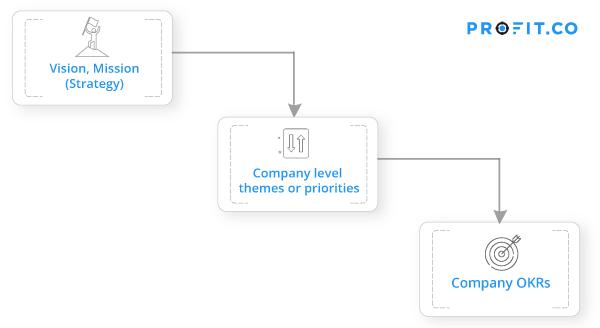
Once you identify your company priorities, you can build off of them. These priorities are then delegated to the departments within your company.
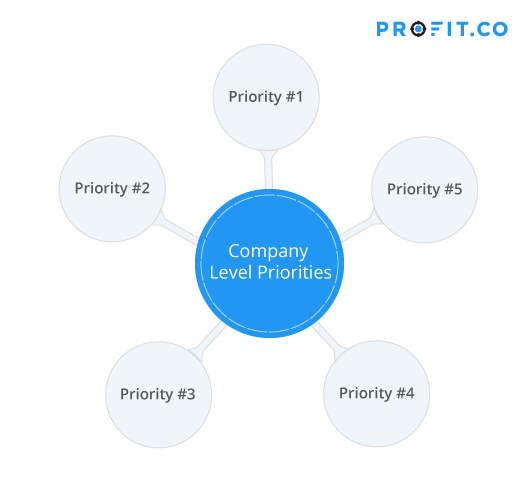
You might call these strategic priorities or strategic initiatives. But, regardless of the terminology, these priorities are the absolute essentials of the company. These are different from your goals. While goals might shift from quarter to quarter, your priorities tend to be more consistent.
An example of these five priorities could be to create an excellent product, have a strong marketing team, promote sales, ensure solid revenue, and ensure the customer success team is amazing. Each of these priorities can be correlated with each department. These are company-level priorities, and characteristics that define your company, its values, mission, and motivation.
Ready to start your OKR Journey for FREE?
Connecting to OKRs
But how do overarching priorities connect to OKRs? OKRs are meant to be more specific and timely, helping a company achieve ambitious goals that will drive progress and success.
There are a few different scenarios that are worth looking at. The above examples of priorities might belong to a well-established company that has a broad set of initiatives across different functions. However, at a start-up that is still in the building stage of product development, then priorities for sales or customer success would not even exist yet. The priority distributions would be different– leaning more heavily toward engineering and product.
The distribution of priorities is entirely dependent on the stage of your business and what your priority then is.
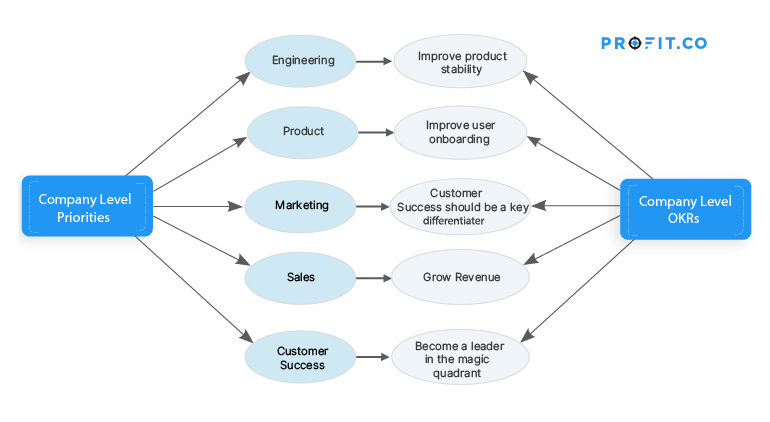
In this example, engineering has a corresponding OKR, called “Improve product stability”. This OKR would work for a team that has built their product but is implementing new features. Within the timeframe of the quarter, they hope to make the product more stable.
Meanwhile, the product team is focused on improving user onboarding. Similarly, the marketing team wants to become a leader in the magic quadrant. When a company focuses its OKRs on these types of goals, it’s safe to say that their product is mature, and they have the bandwidth to focus on non-feature initiatives in the product and engineering space.
From a sales standpoint, the OKR is to grow revenue, while customer success is focused on giving direction to the team.
Primary owner and secondary contributors
In these OKRs, there is a primary driver or primary function, that drives the OKRs. For example, the engineering team drives the OKR to “improve product stability.” Alternatively, the product team drives the OKR to “improve user onboarding.”
While there is a primary owner for each OKR, there are also secondary contributors. For example, for the product team to improve user onboarding, they need the engineering team to contribute data on if there is any abandonment, problems that frequently occur, or other issues that might affect this OKR. The engineering team then must help with implementing solutions so that the product team can succeed.
Similarly, the customer success team must help the product team understand customer behavior, complaints, and challenges. Additionally, they can engage customers to test out solutions. Different departments might directly or indirectly contribute to OKRs.
Alignments
As a company leader, you should pay close attention to the relationships between departments and departmental OKRs. Once you have an understanding of how the departments in your company rely on one another, you can make alignments between their OKRs.
Companies might not be able to fully align their OKRs in their first quarter. It could take two or three quarters before a company can properly recognize the relationships between OKRs. Once you can do this, however, you should decide if it makes more sense to align upward at the company level or align at each function.
From a review standpoint, it’s important to understand how departments connect to one another, and where goals intersect. Instituting clear ownership and maintaining order is important, especially when goals have alignments and dependencies.
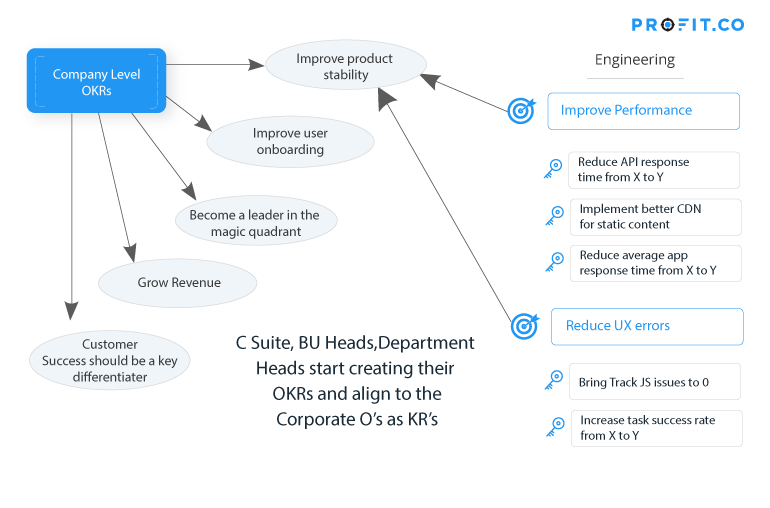
Now, let’s take a look at this example. Here, you have company-level OKRs– five of them:
- Improve product stability
- Improve user onboarding
- Become a leader in the magic quadrant
- Grow revenue
- Customer success should be a key differentiator
The key results for these objectives at the company level are usually determined by C-level executives or BU heads and department heads– some of whom might create department-level OKRs, and align those from the bottom-up as company-level key results.
Take “improve product stability” for example. This is a company-level objective. The engineering department has its objectives to “improve performance” and “reduce UX errors”. Both of these have key results of their own, but the objectives themselves are used as key results for the company-level objectives. When lower-level objectives inform upper-level key results, that is bottom-up alignment. Alternatively, when upper-level key results inform lower-level objectives or key results, that is top-down alignment.
Alignment of any type requires negotiation between the different OKR levels, as well as various department heads. Coordinating on what needs to be accomplished within a quarter, and aligning lower-level goals to higher-order company objectives requires cooperation. Resourcing discussions and coordination is essential for a company to reach its goals across the organization.
Final Thoughts
Refining your OKR program, determining your priorities, and achieving proper alignment are all iterative processes. What works for one company may not work well for another company. However, in following this more general approach to zero in on your vision, priorities, goals, and finally your objectives, you will have a place to start on your OKR journey.
While there’s no hard-and-fast rule for implementing your program, paying close attention to what works and what doesn’t, and being flexible is a necessary component of succeeding with this framework.
Clarity concerning goals, priorities, and actionable steps to success will become clearer the more than you adhere to the framework of OKRs. Once a company hits its stride, OKRs become second-nature and can inform an entire organization’s goals at all levels of the company.
